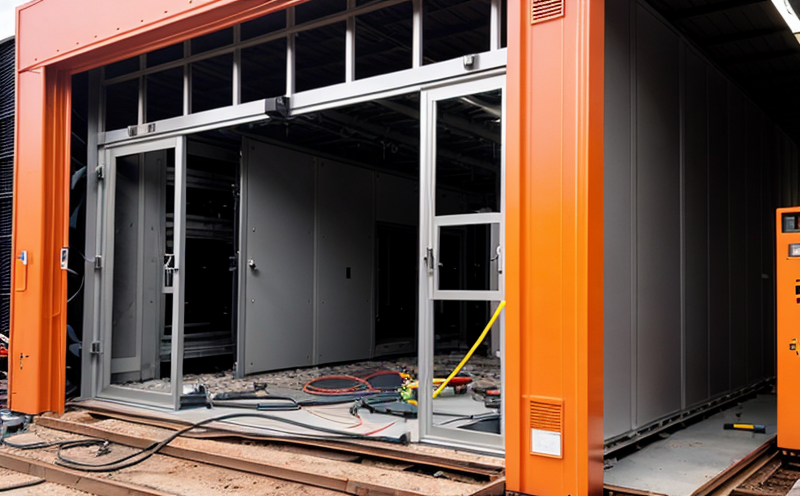DIN EN 62620 Thermal Safety Testing of Large Lithium-Ion Cells
The DIN EN 62620 standard is a crucial benchmark for ensuring the thermal safety and reliability of large lithium-ion cells. This standard applies specifically to electric vehicle (EV) batteries, stationary energy storage systems (ESS), and other large-scale applications where cell integrity plays a key role in system performance and safety.
The primary aim of DIN EN 62620 is to provide a comprehensive framework for assessing the thermal stability and thermal runaway behavior of large lithium-ion cells. This includes understanding how these cells react under extreme conditions, such as overcharging, short circuits, or mechanical abuse. By adhering to this standard, manufacturers can ensure that their products meet stringent safety requirements before being deployed in real-world applications.
The testing procedures outlined in DIN EN 62620 are designed to simulate the worst-case scenarios a cell might encounter during its lifecycle. This ensures that any potential risks are identified early on and mitigated through design improvements or operational adjustments. Compliance with this standard can provide significant competitive advantages by enhancing brand reputation, meeting regulatory requirements, and fostering trust among consumers.
One of the key aspects of DIN EN 62620 is its focus on thermal runaway behavior. A thermal runaway occurs when a cell generates heat faster than it can be dissipated, leading to an exponential increase in temperature which could ultimately cause damage or failure of the battery system. The standard provides detailed guidance on how to conduct tests that mimic such conditions without causing actual harm.
Another important feature of DIN EN 62620 is its emphasis on thermal management systems (TMS). Effective TMS design is essential for managing heat generated by lithium-ion cells and preventing overheating issues. By testing these systems according to the procedures specified in DIN EN 62620, engineers can ensure that their designs are robust enough to handle even the most challenging operating conditions.
Compliance with DIN EN 62620 also involves rigorous inspections of cell packaging and cooling mechanisms. Proper packaging helps protect cells from external factors such as dust, moisture, or physical damage while ensuring proper airflow during operation. Meanwhile, effective cooling systems are vital for maintaining optimal temperatures within the battery pack to prevent overheating.
Testing according to DIN EN 62620 goes beyond just assessing individual cell performance; it also considers how multiple cells interact within larger assemblies like modules or packs. This holistic approach ensures that all components work together seamlessly, providing reliable and safe operation throughout their lifetimes.
In summary, DIN EN 62620 provides a robust set of guidelines for evaluating the thermal stability and safety characteristics of large lithium-ion cells used in various applications such as electric vehicles and stationary energy storage systems. By following these standards closely during development stages, manufacturers can ensure that their products meet high levels of quality while maintaining strict adherence to regulatory frameworks.
Why It Matters
The importance of DIN EN 62620 cannot be overstated given the growing demand for electric vehicles and renewable energy storage solutions. As more countries adopt policies aimed at reducing greenhouse gas emissions, there is increasing pressure on manufacturers to deliver safer, more efficient products that meet strict environmental standards.
- Enhanced Safety: By ensuring compliance with DIN EN 62620, companies can significantly reduce the risk of fires or explosions associated with lithium-ion batteries. This not only protects consumers but also helps safeguard businesses against potential liabilities stemming from accidents involving faulty products.
- Regulatory Compliance: Many governments around the world are implementing regulations that mandate adherence to international standards like DIN EN 62620. Failure to comply could result in penalties or even bans on certain models, severely impacting market access and profitability.
- Better Product Reputation: Demonstrating commitment to rigorous testing procedures boosts customer confidence, leading to increased sales and long-term brand loyalty. It also differentiates companies from competitors who may not prioritize safety or quality as much.
In addition to these tangible benefits, adhering to DIN EN 62620 fosters innovation by encouraging continuous improvement in design practices and material selection for safer batteries. This creates a virtuous cycle where better-performing products lead to higher standards across the industry, ultimately benefiting everyone involved.
Applied Standards
DIN EN 62620 is part of a broader suite of international standards aimed at promoting safety and reliability in large lithium-ion cells. Some related standards include:
- DIN EN 1973:2015-08 - Safety of Electric Vehicles: This standard covers various aspects of electric vehicle safety, including electrical systems, fire protection measures, and crashworthiness.
- ISO/IEC 61851: Part 4 - Charging Systems for Electric Vehicles: It specifies the technical requirements for charging infrastructure used in EVs, ensuring compatibility between vehicles and chargers.
- ASTM G23-09 - Standard Practice for Determining Ultraviolet Weathering Resistance of Organic Coatings: Although not directly related to lithium-ion cells, this standard is often referenced when discussing durability under prolonged exposure to sunlight.
The application of DIN EN 62620 ensures consistency across different testing laboratories worldwide, making it easier for manufacturers to compare results and ensure uniformity in quality control processes. This interoperability fosters collaboration among stakeholders involved in the development and deployment of large lithium-ion cells.
International Acceptance and Recognition
DIN EN 62620 enjoys widespread acceptance across Europe, Australia, and parts of Asia. Here are some notable regions where this standard is recognized:
- European Union (EU): All member states must adhere to EU directives that reference DIN EN 62620 for safety assessments of large lithium-ion cells.
- Australia/New Zealand: The Australian Standards Association has incorporated aspects of DIN EN 62620 into its own guidelines for assessing battery performance in EVs and ESS.
- Japan: While Japan does not formally adopt European standards, many Japanese companies voluntarily follow international best practices like those outlined in DIN EN 62620 to ensure their products meet global expectations.
The broad recognition of DIN EN 62620 underscores its significance as a leading authority on thermal safety testing for large lithium-ion cells. Its adoption by multiple jurisdictions highlights the importance of this standard in shaping industry norms and practices globally.





